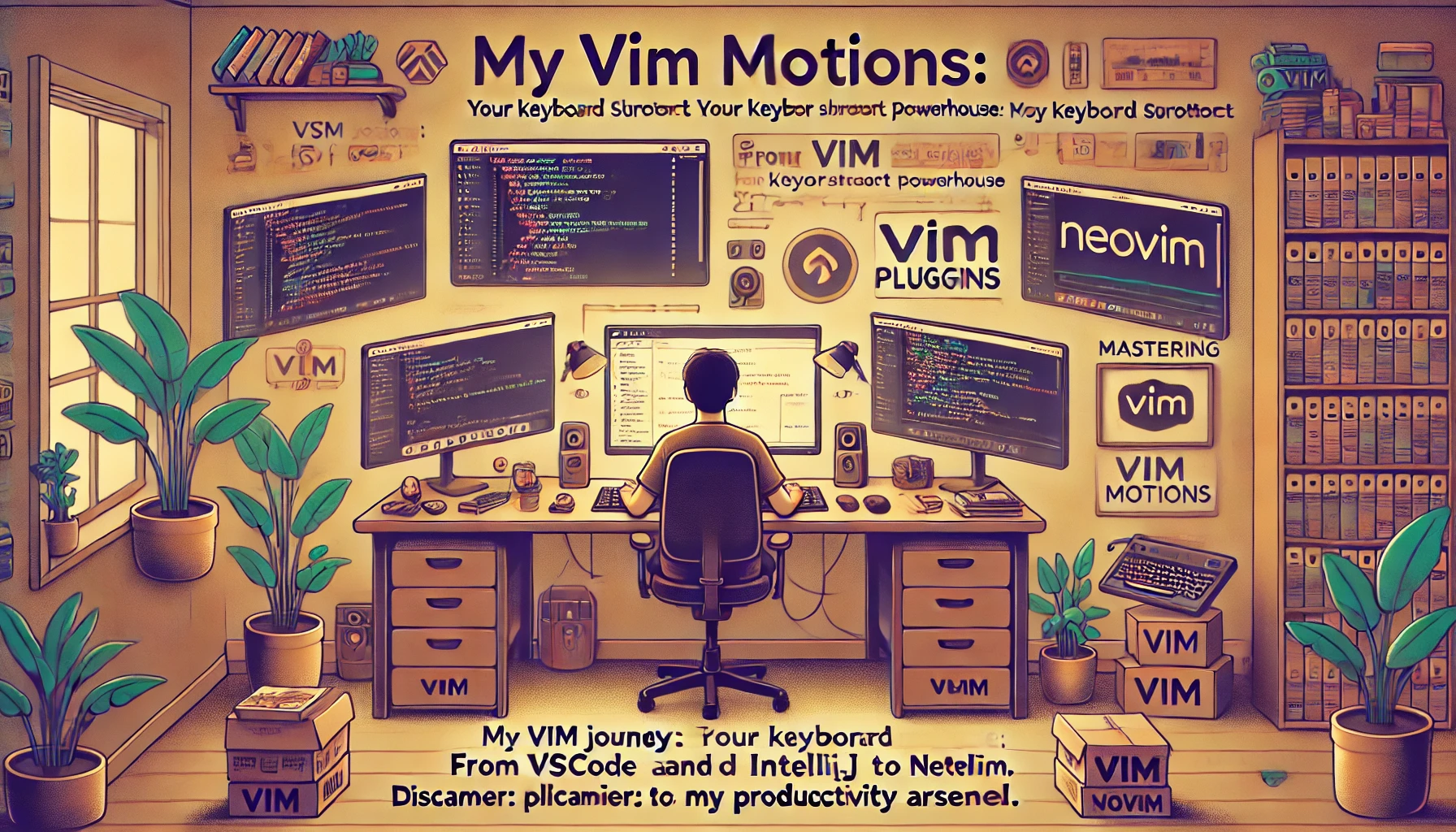Vim Motions: Navigating and Editing Code Efficiently
Vim Motions: Your Keyboard Shortcut Powerhouse
Vim motions are a set of commands that empower you to navigate and edit code like a pro. This guide dives into different Vim motions and how to harness them for lightning-fast coding.
My Vim Journey: From VSCode and IntelliJ to Neovim
After years of using VSCode and IntelliJ, I decided to make the switch to Neovim as my primary development tool. This series of posts will document my journey and share the tips, tricks, and configurations that have made Neovim an indispensable part of my workflow.
Today, we’re starting with the foundation: Vim motions. Mastering these commands is key to unlocking the full potential of Vim’s editing power.
Disclaimer: This is not meant to be a flamewar about editors. It’s simply a reflection of what has worked best for me and an invitation for you to explore if Vim might be a good fit for your own development style.
Vim Plugins: My Productivity Arsenal
One of the things that makes Vim (and Neovim) so powerful is the ability to customize it with plugins. Here are some of the plugins I rely on for maximum productivity:
- “Vundle.vim”
- “undotree”
- “vim-fugitive”
- “gruvbox”
- “copilot.vim”
- “vim-log-highlighting”
- “nerdtree”
- “lightline.vim”
- “vim-gitbranch”
- “vim-terraform”
- “vim-go”
- “fzf”
- “ale”
- “fzf.vim”
- “vim-tmux-navigator”
(Complete plugin setup and details will be covered in future posts.)
The Vim Editor: More Than Meets the Eye
Vim is a highly customizable text editor known for its modal nature. Its modes – Normal, Insert, and Visual – cater to distinct tasks, allowing you to switch seamlessly between command input and text editing.
Vim Plugins: Supercharge Your Vim Experience
Vim’s capabilities extend far beyond its core features. With a vast array of community-maintained plugins, you can transform Vim into a full-fledged Integrated Development Environment (IDE).
Vim Motions in Action
By mastering Vim motions, you’ll write and navigate code with impressive speed. Even popular IDEs like VS Code offer Vim plugins, enabling you to leverage Vim’s navigation within your preferred environment.
Vim Modes:
- Normal Mode: Your command center for issuing instructions.
- Insert Mode: Where the actual code writing happens.
- Visual Mode: Select and manipulate text visually, with options for both normal and block selection.
Vim also has a leader key for creating custom shortcuts, and a command mode for operations like saving files.
Navigating Your Codebase
Let’s dive into a React app and explore how Vim motions streamline navigation:
Basic Movements (h, j, k, l): Forget arrow keys! Use these for left, down, up, and right movement. Prefix with a number (e.g.,
5j) to move multiple lines.Word Navigation (w, b, e): Jump forward (
w), backward (b), or to the end (e) of words. Use a number prefix for multiple word jumps.Line Navigation (0, ^, g, $, f, F): Go to the start (
0), first non-blank character (^), end ($), or search for a character (fforward,Fbackward).Vertical Navigation ((), {}, Ctrl+D/U, Ctrl+F/B, G): Navigate by sentences (
(and)), paragraphs ({and}), half pages (Ctrl+D,Ctrl+U), full pages (Ctrl+F,Ctrl+B), start of file (gg), and end of file (G).
Entering Insert Mode: Multiple Entry Points
Vim offers various ways to enter insert mode:
- Before cursor:
i - After cursor:
a - Beginning of line:
I - End of line:
A - Below current line:
o - Above current line:
O
Other insert mode triggers include c (change), s (substitute), y (yank/copy), and p (paste). You can even copy entire lines with yy.
Learning More
Vim’s learning curve can be steep, but the rewards are immense. To deepen your knowledge:
- Vim Documentation: https://vimdoc.sourceforge.io/index.html
- Vim Tutorial: https://www.tutorialspoint.com/vim/vim_tutorial.htm
- Vim Cheat Sheet: https://www.vim.org/doc/vimtutor/vimtutor.pdf
Happy Vimming!


